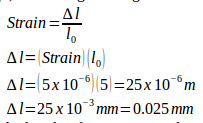Stress Strain Young’s modulus – Problems and Solutions
1. A nylon string has a diameter of 2 mm, pulled by a force of 100 N. Determine the stress!
Known :
Force (F) = 100 N
Diameter (d) = 2 mm = 0.002 m
Radius (r) = 1 mm = 0.001 m
Wanted : The stress
Solution :
Area :
A = π r2
A = (3.14)(0.001 m)2 = 0.00000314 m2
A = 3.14 x 10-6 m2
The stress :
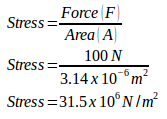
2. A cord has original length of 100 cm is pulled by a force. The change in length of the cord is 2 mm. Determine the strain!
Known :
Original length (l0) = 100 cm = 1 m
The change in length (Δl) = 2 mm = 0.002 m
Wanted : The strain
Solution :
The strain :
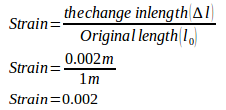
3. A string 4 mm in diameter has original length 2 m. The string is pulled by a force of 200 N. If the final length of the spring is 2.02 m, determine : (a) stress (b) strain (c) Young’s modulus
Known :
Diameter (d) = 4 mm = 0.004 m
Radius (r) = 2 mm = 0.002 m
Area (A) = π r2 = (3.14)(0.002 m)2
Area (A) = 0.00001256 m2 = 12.56 x 10-6 m2
Force (F) = 200 N
Original length of spring (l0) = 2 m
The change in length (Δl) = 2.02 – 2 = 0.02 m
Wanted : (a) The stress (b) The strain c) Young’s modulus
Solution :
(a) The stress
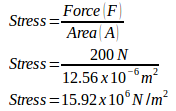
(b) The Strain
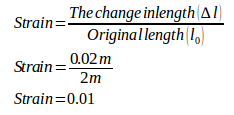
(c) Young’s modulus
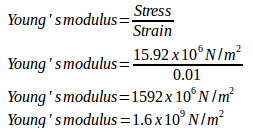
4. A string has a diameter of 1 cm and the original length of 2 m. The string is pulled by a force of 200 N. Determine the change in length of the string! Young’s modulus of the string = 5 x 109 N/m2
Known :
Young’s modulus (E) = 5 x 109 N/m2
Original length (l0) = 2 m
Force (F) = 200 N
Diameter (d) = 1 cm = 0.01 m
Radius (r) = 0.5 cm = 0.005 m = 5 x 10-3 m
Area (A) = π r2 = (3.14)(5 x 10-3 m)2 = (3.14)(25 x 10-6 m2)
Area (A) = 78.5 x 10-6 m2 = 7.85 x 10-5 m2
Wanted : The change in length (Δl)
Solution :
Young’s modulus formula :
![]()
The change in length :
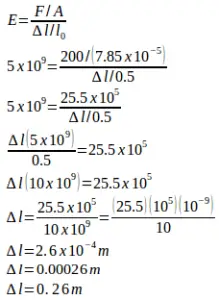
5. A concrete has a height of 5 meters and has unit area of 3 m3 supports a mass of 30,000 kg. Determine (a) The stress (b) The strain (c) The change in height! Acceleration due to gravity (g) = 10 m/s2. Young’s modulus of concrete = 20 x 109 N/m2
Known :
Young’s modulus of concrete = 20 x 109 N/m2
Initial height (l0) = 5 meters
Unit area (A) = 3 m2
Weight (w) = m g = (30,000)(10) = 300,000 N
Wanted : (a) The stress (b) The strain (c) The change in height!
Solution :
(a) The stress
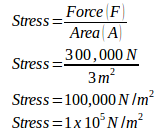
(b) The Strain
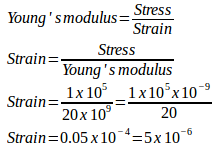
(c) The change in height
